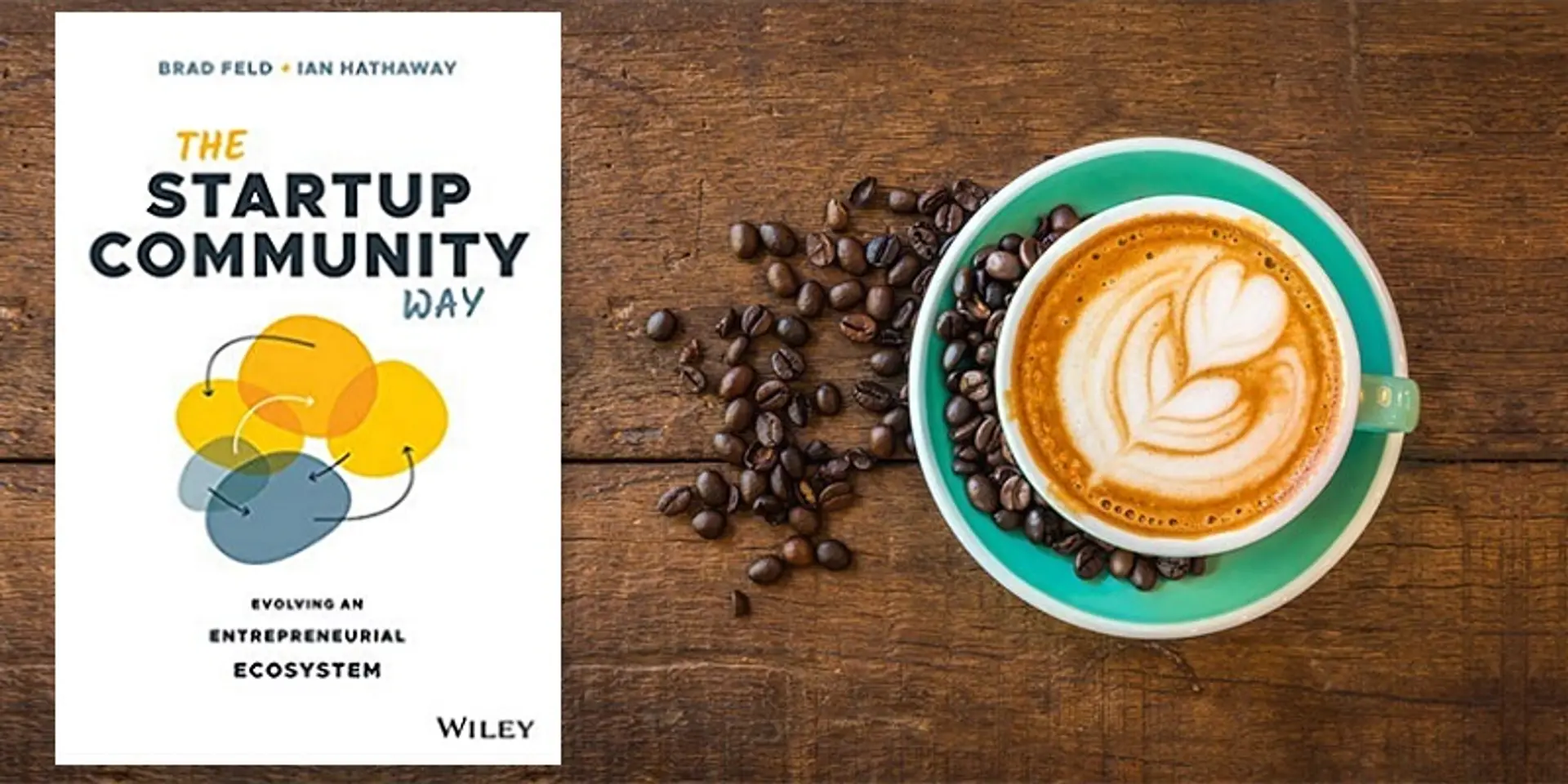Startup Communities – how to map and nurture local entrepreneurship ecosystems
This must-read book describes startup communities as complex adaptive systems, and highlights core principles for success based on a range of case studies.
Launched in 2012, YourStory's Book Review section features over 270 titles on creativity, innovation, entrepreneurship, and digital transformation. See also our related columns The Turning Point, Techie Tuesdays, and Storybites.
Principles and examples of urban innovation ecosystems are well explained in the new book by Brad Feld and Ian Hathaway, The Startup Community Way: Evolving an Entrepreneurial Ecosystem.
It offers theoretical foundations and practical advice for stakeholders who want to harness the power of entrepreneurship in their city. This includes entrepreneurs, community builders, government officials, corporates, professional services firms, tech giants, universities, accelerators, investors, and media.
Brad Feld has been an early-stage investor and entrepreneur for over 30 years. He is a partner at Foundry Group and is a Co-founder of Techstars. See our reviews of his earlier books, Startup Communities and Startup Boards, and author interview.
Ian Hathaway is an analyst, consultant, and writer, spanning areas like entrepreneurship, innovation, cities, and the economy. He is an advisor for leaders in technology, media, and finance, and invests in startups in the US and Europe.
“We need entrepreneurs and their ideas to keep our society moving forward, not just economically but equitably,” Eric Ries writes in the foreword. “The work of innovation is continuous, and thinking truly long term is crucial in order to reap its true benefits,” he adds. See our reviews of his bestselling books The Lean Startup and The Startup Way.
The material is spread across 17 chapters, with plenty of references and sources. There are several case studies from cities across the US, beyond the usual suspects like Silicon Valley. Here are my three clusters of takeaways from this valuable 340-page book, summarised as well in Table 1.
See also my reviews of the related books from the Startup Guide series, featuring entrepreneurship ecosystems in cities like Barcelona, New York, Johannesburg, Cairo, and Singapore. Entrepreneurship support organisation, The Indus Entrepreneurs has 64 chapters in 14 countries; see our profiles of TiE Global and the city chapters of Bangalore, Mumbai, New Delhi-NCR, Silicon Valley, Pune, Kerala, Ahmedabad, and Kolkata.

I. Startup ecosystems
Long-term communities of support and knowledge-sharing between diverse actors play a key role in urban innovation ecosystems, the authors begin. While it is tempting for large players like government and corporations to favour a top-down approach, the authors favour greater support for a bottom-up approach with startup founders at the centre.
Steve Blank defines a startup as an organisation “formed to search for a repeatable and scalable business model”. In that sense, they are different from local small and medium enterprises (SMEs) or entrepreneurs in traditional businesses.
Startup communities are subsets of entrepreneurial ecosystems, which in turn are subsets of innovation ecosystems, the economy, and society. Ecosystems are self-organising, self-governing, and self-sustaining.
They are inter-connected, adaptive and highly localised, the authors explain. Success depends on a good “community-ecosystem” fit (analogous to “product-market” fit).
Ecosystems are important for founders since startups are deficient in some resources and hence more reliant on the external environment. “A healthy startup community is a densely-connected, open, trusting network where the most influential nodes of the network are entrepreneurs,” the authors define.
The startup community is committed to help entrepreneurs succeed. Other ripple effects can be increase in local employment via creation of jobs, commercialisation of university R&D and IP, or acquisition of startups by corporates. But it is key for such urban ecosystems to reach out to startups, seek their inputs, and involve them in decision-making, the authors emphasise.
With their unique mindset and experience, entrepreneurs are role models for other founders and should lead these communities, while larger organisations feed into them. There are also other individuals who play an important role as instigators.
The authors caution that there is an asymmetry between startups and the larger players in the ecosystem, and this should not upset the viability of startups in the community. The hierarchical mode of functioning of large player should not suffocate network-based startup communities.
Dense urban co-location of partners helps accelerate “knowledge spillovers” and “external economies” as well. More tacit knowledge transfers and serendipitous exchanges take place in such contexts. “Startup neighbourhoods” have now emerged within cities, the authors explain.
Cultural amenities also feed into such clusters, as creative classes and high-growth entrepreneurs interact with each other. “Topophilia” or “love of place” helps strengthen the local ecosystem, according to John Hickenlooper, brewpub entrepreneur and former Governor of Colorado.
Successful entrepreneurial communities have a sense of camaraderie, according to Adam Hamilton, Founder of Backstage Capital in Los Angeles. “The intent is the steering wheel. Passion is the accelerator,” he describes.
The authors explain that effective entrepreneurial ecosystems have seven types of capital: intellectual, human, financial, network, cultural, physical, and institutional. For example, cultural capital includes mindset, attitudes and behaviours, while institutional capital refers to laws, markets and stability.
Earlier generations of successful entrepreneurs should contribute to the next generation, but not try to control or stifle them (‘enlightened patriarchs’). There can also be a diaspora element from locals and alumni who now live elsewhere.
Storytelling plays an important part of communication and knowledge transfer in these communities. “The storytelling should go far beyond cheerleading, with a focus on learning in the startup community,” the authors explain. This can be supported by local media, as seen in Startland News in Fort Collins, Colorado.
StartingBlock Madison is a good example of a founder-first ecosystem initiative. A group of seven founders (‘Capital Entrepreneurs’) bought a building to co-locate entrepreneurs, followed by government and corporate support. A VC, an accelerator and a women entrepreneur support organisation also moved in.
Within a decade, the tipping point was reached, and a vibrant startup community took root. Success depends on a “by-entrepreneur-for-entrepreneur” mentality, explains Scott Resnick, COO of StartingBlock Madison.
II. Models
Entrepreneurship ecosystems are not linear systems but complex adaptive systems. The focus should be holistic and on interactions, not just on the actors in the system. They are not formulaic or replicable, and each city’s ecosystem will evolve differently over time, the authors emphasise.
Complex systems are different from simple and complicated systems, and cannot be fully understood, modeled, controlled, predicted or replicated. Progress may be slow and uneven, but phenomena like contagion can rapidly accelerate good (and bad) influences. Experimentation, feedback, and learning are the best way to move such systems to a tipping point, the authors explain.
A systems focus draws attention to parts, relationships, purpose, boundaries, properties of scale, and dimensions of time. There is a perpetual loop of “co-evolution” between the actors and the system as a whole, the authors explain.
“Startup communities can be guided and influenced, but not controlled,” the authors advise. Large firms with hierarchical mindsets have a hard time seeing the holistic view required for community success.
Creativity rises in a complex system through a phenomenon called emergence, as seen in the rise of open source software. It requires synergistic integration and self-organisation, the authors explain. The various combinations can lead to unexpected effects over time as new generations of leaders emerge.
The authors also caution against some myths and traps: quantity, control, blueprints, and metrics.
Throwing top-down inputs at a community by government or corporates is not enough; the key is behavioural change that supports inclusion and collaboration. It is the successful and engaged entrepreneurs (eg. large scale-up outliers, serial founders) who can help drive the next wave of startups.
“The quality of the network is more important than the size of it,” the authors emphasise. High-value participants or supernodes are more important. In complex systems, feedback loops produce unexpected chain reactions.
Influencers should not become stifling gatekeepers; large firms should be open to criticism about how they are perceived by entrepreneurs. However, it is tough for large firms to “let go” – they want to feel intelligent, needed, valuable, and in control, the authors caution.
Entrepreneurs are often more resilient than large incumbents or bureaucracies. Cliques and factions can form in ecosystems, and some entrepreneurs will break away from them.
Benchmarking and comparison between startup ecosystems of different cities can be useful (cross-sectional data). But the authors caution that there are local differences that can’t easily be captured by standardised metrics and ecosystem rankings.
It is as important to measure the growth of an ecosystem over periods of time, and compare mature and early versions of the same ecosystem (longitudinal data). Though Silicon Valley offers useful lessons, too many other cities are trying hard just to be another Silicon Valley instead of a better version of themselves, the authors lament.
“History and local context matter in complex systems,” the authors emphasise. Evolutionary approaches look at phases such as nascent, developing, emerging, sustaining and even declining ecosystems.
The quality of interactions in the ecosystem should be improved, not just the magnitude of resources added. Logical models look at causation effects via outputs, outcomes, assumptions, and goals.
Communities change over time, and it is important to experiment and refine ecosystem models, advises Rhett Morris, Partner, Common Good Labs. “Praise and raise,” he adds, referring to promotion of expected behaviours and role models.
The authors also draw on AnnaLee Saxenian’s classic work chronicling the rise of Silicon Valley over the Route 128 corridor near Boston. Horizontal, fluid and open flows of information and labour mobility won out over vertical integration and closed systems in the 1980s.
Mark Suster launched Upfront Ventures in Los Angeles while also helping the local ecosystem evolve via publicising its strengths and hosting events like the Upfront Summit. The University of Colorado’s New Venture Challenge is a pre-accelerator programme, which showcases and promotes entrepreneurial activity from all departments and fields under one roof.
The cleverly named and designed Portland Incubator Experiment (PIE) morphed from a curated co-working space to a local accelerator. Learnings from successes and failures were captured in the PIE Cookbook. The key is to be a community resource engaged and maintained by the community, explains Rick Turoczy, PIE Founder.
Scott Dorsey from Indianapolis founded and sold ExactTarget to SalesForce, and helped build a strong local startup community. The city has attracted large tech firms, and the state has created a fund for startups. Scott also founded a VC (High Alpha Capital) and company builder (High Alpha Studio).
University of Utah’s Lassonde Entrepreneur Institute puts students in charge of most things. It fulfils their requirements like residential facilities in the community entrepreneur space, 24X7 access to the campus, and learning on demand.
“Every entrepreneur dreams of building something bigger than themselves,” Scott enthuses.
Seattle’s Office of Economic Development ropes in entrepreneurs rather than career bureaucrats for key roles in entrepreneurship development. The government helps by connecting entrepreneurs, offering skills programmes (eg. via partners like Code.org), providing financial incentives, and promoting stories of local startups.
Silicon Valley’s journey actually spans a century, and there was no central plan or blueprint. “Today, even Silicon Valley couldn’t recreate itself,” the authors add. Its story spans the defence sector, the rise of companies like Fairchild Semiconductor and HP, the role of universities like Stanford, and many other factors.
III. Core principles
To start, sustain and scale a virtuous cycle of entrepreneurship and startups, there should be support for core principles and values: trust, good faith, respect, humility, openness, inclusion, collaboration, support, shared sense of purpose, and continuous activities.
The ‘Boulder Thesis’ is based on four principles: the entrepreneurs’ role as leaders of the startup community, planning for a period of 20 years in the future, inclusion, and engaging activities. The authors supplement these with eight other principles based on complex adaptive systems.
Principles of inclusion and diversity take some effort to implement since humans are generally hardwired to distrust people who are different, according to Victor Hwang and Greg Horowitt, authors of The Rainforest: The Secret to Building the Next Silicon Valley.
“Diversity is survival,” the authors evocatively describe. “A radical embrace of inclusion helps because the best ideas often come from unexpected places,” they add. The focus should be on “culture add” and not just “culture fit.”
Identity diversity and cognitive diversity are both important, embracing people of different origins, race, gender, fields and skills. Such people should be welcome, respected and able to participate fully, the authors suggest.
Diversity is not just a good moral or ethical practice, but is profitable. It can open up unseen markets, according to Miriam Rivera, MD of Ulu Ventures.
“Adopt a mindset of abundance rather than scarcity,” the authors advise. Ecosystems are positive-sum games and not zero-sum games, and everyone gains by being a positive contributor to the collective. “Founders first” and “give first” are essential attitudes to follow and practice.
The “iceberg model” of systems thinking has events and activities at the top, which build on underlying patterns, trends, structures, and mental models (worldviews based on assumptions and beliefs).
Community spaces, storytelling activities, smooth information flows, and collaboration can be effective “leverage points,” the authors describe. Bridging and bonding practices are important for collaboration between and within groups.
Successful entrepreneurs should become mentors, and share their wisdom, energy and time. As role models, they motivate aspiring entrepreneurs to take their own leaps. “Being visible, telling stories, and elevating successful entrepreneurial leaders is critical,” the authors emphasise.
Having a long-term view of at least 20 years is important to sustain an entrepreneurial ecosystem, according to the authors.
The community should be proactive, and continually engaged in stimulating activities like demos, hackathons and topical meetups. A mature community may even have more than one startup activity each day.
MIT promotes and cultivates an entrepreneurial community in its campus via a systems-thinking approach of experimentation and iteration. It also follows the ‘4 H’ principles of hands, heart, head, and home to promote local entrepreneurship as a craft.
A group of 75 individuals in New York city created The Fund as an investment vehicle and community development endeavour. This eventually helped bridge the funding gap for local entrepreneurs, according to Jenny Fielding, Founder of The Fund and Managing Director of Techstars.
Having a long-term view of committed leadership helped transform and accelerate the startup community in Durham, North Carolina, according to Chris Heivly, SVP of Techstars. After the collapse of the tobacco industry, local leaders rallied entrepreneurs into a space called the American Underground in 2009.
Accelerators and successful founders became anchor tenants, and a wide range of formal and informal community activities helped increase entrepreneurial density. This bottom-up and generational view helped create the necessary magic.
“The complexity lens has illuminated the paths for us in better understanding and engaging with startup communities,” the authors sign off.
In sum, this is a must-read book for entrepreneurs, policymakers, corporates, investors and educators on how they can collaborate to create a win-win outcome for all players. A mature and sustainable startup community benefits founders as well as a broader range of innovators and stakeholders, which is particularly relevant in the times of the pandemic crisis and beyond.










